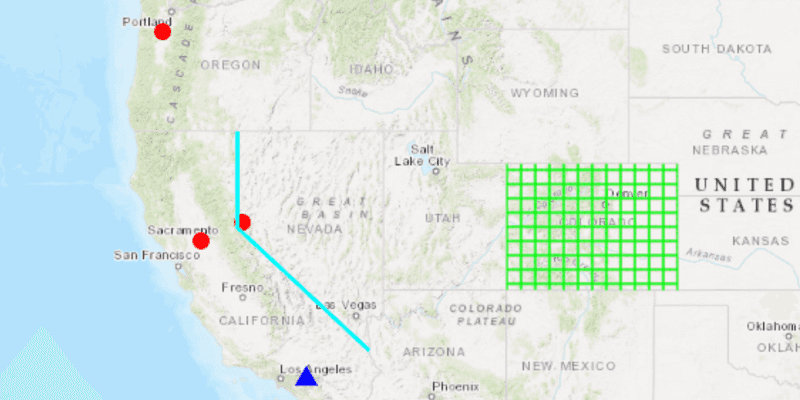Create simple geometry types.

Use case
Geometries are used to represent real world features as vector GIS data. Points are used to mark specific XY locations, such as landmarks and other points of interest. Polylines are made up of 2 or more XY vertices and can be used to mark roads, flight paths, or boundaries. Polygons are made up of 3 or more XY vertices and can be used to represent a lake, country, or a park. Geometries can be stored as features in a database, displayed as Graphics in a map, or used for performing spatial analysis with GeometryEngine or a GeoprocessingTask.
How to use the sample
Pan and zoom freely to see the different types of geometries placed onto the map.
How it works
- Use the constructors for the various simple
Geometrytypes includingPoint,Polyline,Multipoint,Polygon, andEnvelope. - To display the geometry, create a
Graphicpassing in the geometry, and aSymbolappropriate for the geometry type. - Add the graphic to a graphics overlay and add the overlay to a map view.
Relevant API
- Envelope
- Multipoint
- Point
- PointCollection
- Polygon
- Polyline
Additional information
A geometry made of multiple points usually takes a PointCollection as an argument or is created through a builder.
Tags
area, boundary, line, marker, path, shape
Sample Code
/*
* Copyright 2018 Esri.
*
* Licensed under the Apache License, Version 2.0 (the "License"); you may not
* use this file except in compliance with the License. You may obtain a copy of
* the License at
*
* http://www.apache.org/licenses/LICENSE-2.0
*
* Unless required by applicable law or agreed to in writing, software
* distributed under the License is distributed on an "AS IS" BASIS, WITHOUT
* WARRANTIES OR CONDITIONS OF ANY KIND, either express or implied. See the
* License for the specific language governing permissions and limitations under
* the License.
*/
package com.esri.samples.create_geometries;
import java.util.Arrays;
import javafx.application.Application;
import javafx.scene.Scene;
import javafx.scene.layout.StackPane;
import javafx.stage.Stage;
import com.esri.arcgisruntime.ArcGISRuntimeEnvironment;
import com.esri.arcgisruntime.geometry.Envelope;
import com.esri.arcgisruntime.geometry.Multipoint;
import com.esri.arcgisruntime.geometry.Point;
import com.esri.arcgisruntime.geometry.PointCollection;
import com.esri.arcgisruntime.geometry.Polygon;
import com.esri.arcgisruntime.geometry.Polyline;
import com.esri.arcgisruntime.geometry.SpatialReferences;
import com.esri.arcgisruntime.mapping.ArcGISMap;
import com.esri.arcgisruntime.mapping.BasemapStyle;
import com.esri.arcgisruntime.mapping.view.Graphic;
import com.esri.arcgisruntime.mapping.view.GraphicsOverlay;
import com.esri.arcgisruntime.mapping.view.MapView;
import com.esri.arcgisruntime.symbology.SimpleFillSymbol;
import com.esri.arcgisruntime.symbology.SimpleLineSymbol;
import com.esri.arcgisruntime.symbology.SimpleMarkerSymbol;
public class CreateGeometriesSample extends Application {
private MapView mapView;
@Override
public void start(Stage stage) {
try {
// create stack pane and application scene
StackPane stackPane = new StackPane();
Scene scene = new Scene(stackPane);
// set title, size, and add scene to stage
stage.setTitle("Create Geometries Sample");
stage.setWidth(800);
stage.setHeight(700);
stage.setScene(scene);
stage.show();
// authentication with an API key or named user is required to access basemaps and other location services
String yourAPIKey = System.getProperty("apiKey");
ArcGISRuntimeEnvironment.setApiKey(yourAPIKey);
// create a map with the topographic basemap style
ArcGISMap map = new ArcGISMap(BasemapStyle.ARCGIS_TOPOGRAPHIC);
// create a map view and set the map to it
mapView = new MapView();
mapView.setMap(map);
// create a graphics overlay for displaying different geometries as graphics
GraphicsOverlay graphicsOverlay = new GraphicsOverlay();
mapView.getGraphicsOverlays().add(graphicsOverlay);
// create a point geometry
Point point = new Point(-117.195800, 34.056295, SpatialReferences.getWgs84());
Graphic pointGraphic = new Graphic(point, new SimpleMarkerSymbol(SimpleMarkerSymbol.Style.TRIANGLE, 0xFF0000FF, 14));
// create a multipoint geometry
PointCollection stateCapitalsPST = new PointCollection(SpatialReferences.getWgs84());
stateCapitalsPST.add(-121.491014, 38.579065); // Sacramento, CA
stateCapitalsPST.add(-122.891366, 47.039231); // Olympia, WA
stateCapitalsPST.add(-123.043814, 44.93326); // Salem, OR
stateCapitalsPST.add(-119.766999, 39.164885); // Carson City, NV
Multipoint multipoint = new Multipoint(stateCapitalsPST);
Graphic multipointGraphic = new Graphic(multipoint, new SimpleMarkerSymbol(SimpleMarkerSymbol.Style.CIRCLE,
0xFFFF0000, 12));
// create a polyline geometry
PointCollection borderCAtoNV = new PointCollection(SpatialReferences.getWgs84());
borderCAtoNV.add(-119.992, 41.989);
borderCAtoNV.add(-119.994, 38.994);
borderCAtoNV.add(-114.620, 35.0);
Polyline polyline = new Polyline(borderCAtoNV);
Graphic polylineGraphic = new Graphic(polyline, new SimpleLineSymbol(SimpleLineSymbol.Style.SOLID, 0xFF00FFFF,
3));
// create a polygon geometry
PointCollection coloradoCorners = new PointCollection(SpatialReferences.getWgs84());
coloradoCorners.add(-109.048, 40.998);
coloradoCorners.add(-102.047, 40.998);
coloradoCorners.add(-102.037, 36.989);
coloradoCorners.add(-109.048, 36.998);
Polygon polygon = new Polygon(coloradoCorners);
Graphic polygonGraphic = new Graphic(polygon, new SimpleFillSymbol(SimpleFillSymbol.Style.CROSS, 0xFF00FF00,
null));
// create an envelope
Envelope envelope = new Envelope(-123.0, 33.5, -101.0, 48.0, SpatialReferences.getWgs84());
// use the envelope to set the viewpoint
mapView.setViewpointGeometryAsync(envelope);
// add all of the graphics to the graphics overlay
graphicsOverlay.getGraphics().addAll(Arrays.asList(multipointGraphic, polylineGraphic, polygonGraphic,
pointGraphic));
// add the map view to the stack pane
stackPane.getChildren().addAll(mapView);
} catch (Exception e) {
// on any error, display the stack trace.
e.printStackTrace();
}
}
/**
* Stops and releases all resources used in application.
*/
@Override
public void stop() {
if (mapView != null) {
mapView.dispose();
}
}
/**
* Opens and runs application.
*
* @param args arguments passed to this application
*/
public static void main(String[] args) {
Application.launch(args);
}
}